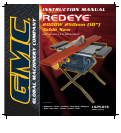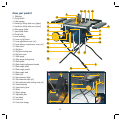
5
7. Dress correctly. Do not wear loose clothing or jewellery.
They can be caught in moving parts. Rubber gloves
and non-slip footwear are recommended when working
outdoors. If you have long hair, wear a protective hair
covering.
8. Use safety accessories. Safety glasses and earmuffs
should always be worn. A face or dust mask is also
required if the sanding operation creates dust.
9. Do not abuse the power cord. Never pull the cord to
disconnect the tool from the power point. Keep the cord
away from heat, oil and sharp edges.
10. Secure the work piece. Use clamps or a vice to hold
the work piece. It is safer than using your hand and
frees both hands to operate the tool.
11. Do not overreach. Keep your footing secure and
balanced at all times.
12. Look after your tools. Keep tools sharp and clean for
better and safer performance. Follow the instructions
regarding lubrication and accessory changes. Inspect
tool cords periodically and, if damaged, have them
repaired by an authorised service facility. Inspect
extension cords periodically and replace them if
damaged. Keep tool handles dry, clean and free from
oil and grease.
13. Disconnect idle tools. Switch off the power and
disconnect the plug from the power point before
servicing, when changing accessories and when the
tool is not in use.
14. Remove adjusting keys and wrenches. Check to see
that keys and adjusting wrenches are removed from
the tool before switching on.
15. Avoid unintentional starting. Always check that the
switch is in the OFF position before plugging in the
tool to the power supply. Do not carry a plugged in
tool with your finger on the switch.
16. Use outdoor rated extension cords. When a tool
is used outdoors, use only extension cords that are
intended for outdoor use and are so marked.
17. Stay alert. Watch what you are doing. Use common
sense. Do not operate a power tool when you are tired.
18. Check for damaged parts. Before using a tool,
check that there are no damaged parts. If a part is
slightly damaged, carefully determine if it will operate
properly and perform its intended function. Check for
alignment of moving parts, binding of moving parts,
breakage of parts, proper mounting and any other
conditions that may affect the operation of the tool.
A part that is damaged should be properly repaired
or replaced by an authorised service facility, unless
otherwise indicated in this Instruction Manual.
Defective switches must be replaced by an authorised
service facility. Do not use a tool if the switch does
not turn the tool on and off correctly.
19. Guard against electric shock. Prevent body contact
with grounded objects such as water pipes, radiators,
cookers and refrigerator enclosures.
20. Use only approved parts. When servicing, use only
identical replacement parts. Use an authorised service
facility to fit replacement parts.
Additional safety rules for table saws
• Always pull the plug out of the power socket before
adjusting or servicing the machine.
• Give these safety regulations to all persons who work on
the machine.
• Do not use this saw to cut firewood.
• Caution! Hands and fingers may be injured on the
rotating saw blade.
• Before you use the machine for the first time, check
that the voltage marked on the rating plate is the same
as your mains voltage.
• If you need to use an extension cable, make sure its
conductor cross-section is large enough for the saw’s
power consumption. Minimum cross-section: 1.0mm2.
• Do not use or leave the saw in the rain and never use it
in damp, humid, or wet conditions.


















